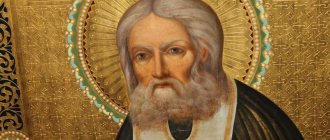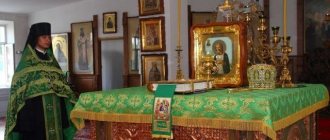St. Seraphim of Sarov is one of the most revered saints in Rus'. The life of Seraphim of Sarov tells how miracles began to happen to him already in childhood, and having become a monk, the Monk Seraphim began to manifest them himself - first of all, with the incredible feats that he performed: for example, he prayed on a stone for three years and almost did not eat at the same time food. Or he fed wild animals that flocked to him from all over the forest and became meek next to them.
But St. Seraphim is one of those saints who left behind not only the tradition of his own ascetic life, but also teachings (if not a whole teaching): about grace. He taught: Christianity is not a set of ethical rules, where it is important to simply be a good person, but a higher goal - having acquired the grace of the Holy Spirit, to change nature
person. And then the person will be sanctified, and the world around him will be transformed in the most miraculous way!
Venerable Seraphim of Sarov feeds a bear
Teachings of St. Seraphim of Sarov
To some extent, teachings are truly the most important thing that Saint Seraphim of Sarov left behind.
“Acquire a peaceful spirit and thousands around you will be saved,” this is one of the most famous sayings of St. Seraphim of Sarov, which simply and briefly conveys the whole essence of his teaching.
Finding peace in the soul and acquiring grace: this is the main goal for a Christian, and not fulfilling the commandments. Fulfilling the commandments is natural for a person, and this must be done in any case, but a person has a higher purpose on earth than simply doing good deeds and not offending loved ones. This goal is deification
: that is, a change in the nature of the soul is already here - on earth.
In fact, the Monk Seraphim of Sarov tried to convey the ideas of hesychasm - the “Greek” teaching, one of whose apologists was St. Gregory Palamas in the 14th century, and which is being built to this day on Holy Mount Athos. The idea of hesychasm is based on the doing of the mind, and not just actions.
Saint Gregory Palamas
The Monk Seraphim of Sarov reminded that the life of a Christian begins not with actions, or even with thoughts, but even earlier - with the nature of his soul. Therefore, an Orthodox Christian must follow not only his thoughts (because all actions come from them), but direct his hope and aspirations further - to the state of his soul. A soul that cries for the Holy Spirit and finds its true integrity and true healing only through the acquisition of Grace and thus in Christ.
Well, keeping the commandments and a pious life are just one of the best tools for achieving this highest goal - acquiring a “peaceful spirit.”
Seraphim of Sarov: years of life - when he lived
The Monk Seraphim of Sarov lived in the 18th–19th centuries. He was born in 1754 and died in 1833.
He lived for 78 years, and during this time the country in which he lived - the Russian Empire - survived six emperors and changed a lot: from a large state it became a real Empire, which was able to eventually defeat Napoleon himself.
The rulers who were “found” by Saint Seraphim of Sarov: Empress Elizabeth; Peter II; Catherine II; Peter III; Alexander I; Nicholas I. Although, of course, the Monk Seraphim himself thought least of all about the kings of the earth and thought more about the Eternal Kingdom, which is what his life tells about.
Letter
During the Sarov celebrations on the occasion of the discovery of the relics of the elder, Nicholas II received the so-called “letter from the past.” The message was written by St. Seraphim and addressed to the “fourth sovereign,” who will arrive in Sarov “to pray especially for me.” What was in the letter is not known for certain - neither the original nor copies have survived.
According to the stories of the daughter of Seraphim Chichagov, the Emperor, who accepted the message sealed with soft bread, put it in his breast pocket with a promise to read it later. When Nikolai read the message, he “cryed bitterly” and was inconsolable. Presumably the letter contained a warning about future bloody events, instructions and strengthening in faith, so that in difficult moments of severe trials the Emperor would not lose heart and carry his heavy martyr’s cross to the end.
Seraphim of Sarov: short biography
Biographies of saints in the Church are usually called “lives.” The life of St. Seraphim is quite comprehensive, because the elder led a very simple lifestyle and sought monasticism from his youth.
Therefore, the brief life of Saint Seraphim can be summarized in just a few phrases:
- born 1833;
- at the age of 22 he left home and became a monk,
- ten years later he was tonsured a monk,
- spent his entire monastic life in the forests near the Sarov monastery or in seclusion in the monastery itself
- and died at the age of 78.
However, the life of any ascetic is made up not of external facts, but of the routine of life and the structure of internal life - which is difficult to describe on the pages of books or a website. And the life of Seraphim of Sarov was filled with inner deeds, which showed that with true unity with the Lord, human strength is truly inexhaustible, and grace can sanctify a person so that wild animals will come to him to worship, and no robbers - neither heavenly, nor even more so earthly ones will not be afraid of him!
Miracles of St. Seraphim of Sarov
Miraculous phenomena began to happen to the Monk Seraphim when he was still a seven-year-old boy, Prokhor. He fell from the bell tower to the ground, but remained alive.
The feats that he accomplished while staying in the forest for thirty years can also be considered a real miracle - but more on that below.
His holy life made the most formidable animals meek. The monk said that wolves, hares, foxes, snakes and mice, and even a big bear came to him at night. And he fed everyone, and miraculously there were enough treats for everyone. “No matter how much bread I took,” said the ascetic, “it miraculously did not decrease in the basket!”
Like any saint, the Monk Seraphim of Sarov did not strive to work miracles, and in any miraculous phenomenon he saw first of all the generosity and Love of God and an example of how boundless the world becomes during life with Christ.
The attacks of the devil intensified. At first they manifested themselves in a mystical way - during prayer, Elder Seraphim could be thrown up and thrown back to the ground - these were the demons “having fun”. And one day, during his exploits in the forest, he was attacked by real robbers. It was the devil, seeing the spiritual firmness of the elder, who now attacked, using earthly “improvised” tools—people—to break the monk’s spirit in such an “earthly” way.
The robbers beat the monk, broke his ribs, fractured his skull and inflicted many other wounds. The wounded Seraphim of Sarov was found some time later, and the doctors were surprised: it was unclear how he remained alive. The monk himself said that on one of these days the Mother of God appeared to the monk, and this finally calmed him down, helped him surrender everything to the will of God and thereby save his life.
The appearance of the Mother of God to St. Seraphim of Sarov is also one of the miracles that happened to him more than once. According to legend, there were twelve of them. The first - in childhood, when Prokhor was 9 years old - the boy was seriously ill and the Mother of God promised to heal him. It was after this that he decided to become a monk. And the last appearance happened a couple of years before his death - when the Most Holy Theotokos appeared to him surrounded by John the Baptist, John the Theologian and 12 virgins.
Bear, groove and crackers
There is several evidence of the “communication” of the Holy Elder with the bear. The Sarov monk Peter said that the priest fed the bear with crackers, and the head of the Lyskovsky community, Alexandra, asked the bear “not to scare the orphans” and to bring honey for the guests. But the most striking story is the story of Matrona Pleshcheeva, who, despite the fact that she “fell unconscious,” retells what was happening with documentary accuracy. Isn’t this the usual Russian cunning here, the desire to join in with the “glory” of Seraphim? After all, before her death, Matrona admits that this episode was invented by a certain Joasaph. According to his teaching, she promised to tell the story while members of the royal family were in the monastery.
Controversy is also generated by the “canal of the Queen of Heaven” created during the life of Seraphim of Sarov, along which today believers walk with a prayer to the Mother of God, and at the end of the path they receive crackers, consecrated in the priest’s cast iron, exactly the same as the miracle worker treated his guests. Did the elder have the right to “invent” such a ritual? It is known that initially the arrangement of the ditch was of practical importance - the impressive size of the ditch protected the nuns from unkind people, the Antichrist.
Over time, the ditch, Seraphim’s crackers, the earth they took with them, and even tapping on sore spots with that same hatchet acquired enormous significance for the pilgrims. Sometimes even more than traditional church services and sacraments.
The exploits of St. Seraphim of Sarov
The future Elder Seraphim accomplished his first visible feat even before he was tonsured a monk - when he went on foot from Kursk, where he was born and lived, to the Kiev Pechersk Lavra: to venerate the relics of the Pechersk saints and receive a blessing for monasticism. He did not travel by train, he did not travel by car, and he did not fly by plane. In those days, pilgrimage was not a comfortable “tourism”, as it is now, but truly a feat.
Kiev-Pechersk Lavra, XIX century
But of course, most of all he became famous for the asceticism he carried out while already a monk. From the very beginning, he stood out from the brethren by his strict rules. And he spent 30 years of his life either as a hermit in the forest, a few kilometers from the Sarov monastery, or in the monastery itself, but in seclusion.
His way of life in the forest seems incredible. Saint Seraphim could wear the same clothes all year round, he wore chains, and at times he ate only grass.
His most famous feat is the feat of stylite, when he stood in prayer alternately on two stones for a thousand days and a thousand nights.
He began to receive visitors only in the last years of his life - and it was then that people learned about Seraphim of Sarov and glorified him as a saint during his lifetime.
The relics of Seraphim of Sarov: where are they located?
The relics of St. Seraphim of Sarov are now kept in the Seraphim-Diveevsky Monastery.
There you can worship them. Diveevsky Monastery is located in the Nizhny Novgorod region. From Moscow, for example, you can get by train to Nizhny Novgorod and then by bus to Diveevo. The bus schedule can be found here
By car: 450 kilometers from Moscow.
There are hotels and private houses at the monastery and you can always find somewhere to stay, but it is better to book accommodation in advance - especially on great Church holidays or on the days of the saint’s memory.
And in Moscow there is the Diveevsky Monastery Compound - it is located a two-minute walk from the Prospekt Mira-Koltsevaya metro station - if you follow the path to the Garden Ring. The courtyard with a house church inside is located right on Prospekt Mira:
House temple: what is it and how does it differ from an ordinary temple?
Praying on the stone
Quite often Sarovsky is depicted praying on a stone. It is known that the monk prayed for a thousand nights on a stone in the forest and for a thousand days on a stone in his cell. The feat of prayer of Seraphim of Sarov on the stone was not documented by the abbot of the Sarov monastery, Nifont. This may be due to the fact that in the Orthodox tradition, kneeling is rather the exception than the rule (one kneels during the transfer of shrines, during the kneeling prayer on the Day of the Holy Trinity, during the priest’s call to “Bend the knee, let us pray”). Praying on your knees is traditionally considered a custom of the Catholic Church and, by the way, is completely excluded among the Old Believers.
There is a version that the Renovationists wanted to use Sarovsky’s feat, trying to find allies in the “Catholic brothers” in reforming “outdated Orthodoxy.” Sarovsky himself said that he did not know whether Catholics would be saved, only that he himself could not be saved without Orthodoxy.
According to legend, the monk reported his deed for edification only to a few at the end of his life, and when one of the listeners doubted the possibility of such a long prayer, and even on a stone, the elder remembered Saint Simeon the Stylite, who spent time on a pillar in prayer 30 years. But: Simeon the Stylite stood, and was not kneeling. The plot of “praying on a stone” also refers to the prayer for the cup, which Jesus performed on the night of his arrest, standing on a stone.








